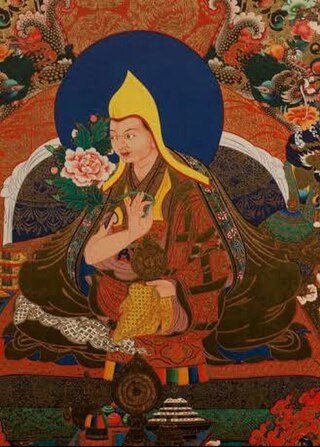
The 1st Dalai Lama, Gedun Drupa was a student of Je Tsongkhapa, and became his first Khenpo (Abbott) at Ganden Monastery. He also founded Tashi Lhunpo Monastery in Shigaste. He was posthumously awarded the spiritual title of Dalai Lama.
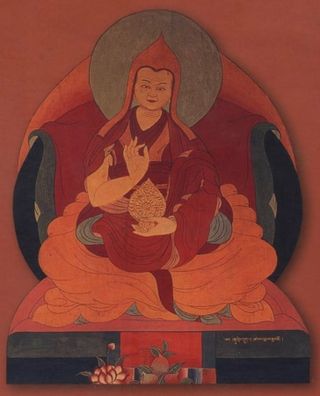
The 6th Dalai Lama, Tsangyang Gyatso, was recognized as the 6th Dalai Lama after a delay of many years, permitting the Potala Palace to be completed. He was an unconventional Dalai Lama that preferred a Nyingma school yogi's life to that of an ordained monk. He was later kidnapped and deposed by the Koshut Lha-bzang Khan.
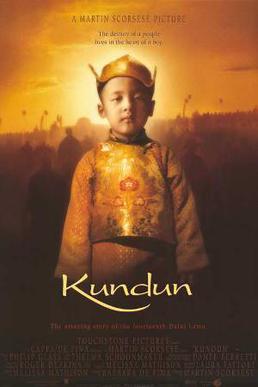
Kundun is a 1997 American epic biographical film written by Melissa Mathison and directed by Martin Scorsese. It is based on the life and writings of Tenzin Gyatso, the 14th Dalai Lama, the exiled political and spiritual leader of Tibet. Tenzin Thuthob Tsarong, a grandnephew of the Dalai Lama, stars as the adult Dalai Lama, while Tencho Gyalpo, a niece of the Dalai Lama, appears as the Dalai Lama's mother.
Thubten Shedrup Ling is the first Tibetan Buddhist monastery in Australia. It is located near Bendigo, Victoria, and is a member of the International Mahayana Institute of the Foundation for the Preservation of the Mahayana Tradition (FPMT).

The Tibetan Institute of Performing Arts (TIPA) was founded by Tenzin Gyatso, the 14th Dalai Lama on reaching McLeod Ganj, Himachal Pradesh, India in exile from Tibet in August 1959. It was then called Tibetan Music, Dance and Drama Society, which was one of the first institutes set up by the Dalai Lama, and was established to preserve Tibetan artistic heritage, especially opera, dance, and music.

Lhalu Tsewang Dorje commonly known as Lhalu, Lhalu Se, or Lhalu Shape, was a Tibetan aristocrat and politician who held a variety of positions in various Tibetan governments before and after 1951.

The Kashag was the governing council of Tibet during the rule of the Qing dynasty and post-Qing period until the 1950s. It was created in 1721, and set by Qianlong Emperor in 1751 for the Ganden Phodrang in the 13-Article Ordinance for the More Effective Governing of Tibet. In that year the Tibetan government was reorganized after the riots in Lhasa of the previous year. The civil administration was represented by the Council (Kashag) after the post of Desi was abolished by the Qing imperial court. The Qing imperial court wanted the 7th Dalai Lama to hold both religious and administrative rule, while strengthening the position of the High Commissioners.

Lodi Gyaltsen Gyari Rinpoche, Kasur Lodi Gyari or "as he is universally known to the Tibetan-speaking world, Gyari Rinpoche" was a Tibetan politician, and journalist who served as the 14th Dalai Lama's special envoy to the United States. Exiled to India in 1959, he was also the executive chairman of the International Campaign for Tibet.
The Mirror of News or Mirror of News from All Sides of the World was a Tibetan-language newspaper published in Kalimpong, India, from 1925 to 1963 and circulated primarily in Tibet but eventually with subscribers worldwide. Its founder was Gergan Tharchin who was at the same time its journalist, editor, and manager.

Tenzing Sonam is a Tibetan film director, writer and essayist based in Dharamshala. He works through his production company, White Crane Films, which he runs with his partner, Ritu Sarin.

Tashi Tsering also called Tashi Tsering Josayma; born in 1960, is a Tibetan tibetologist, historian and writer.
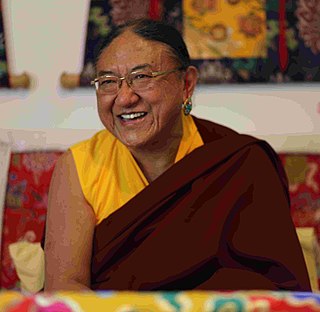
Sakya Trizin Ngawang Kunga served as the 41st Sakya Trizin, the throne holder of the Sakya Lineage of Tibetan Buddhism, from his appointment in 1952 until his retirement in 2017. His religious name is Ngawang Kunga Tegchen Palbar Trinley Samphel Wangyi Gyalpo. After passing the throne of the Sakya lineage to his elder son Ratna Vajra Rinpoche who became the 42nd Sakya Trizin on 9 March 2017, he is now known as Kyabgon Gongma Trichen Rinpoche.

Lobsang Dolma Khangkar also called Lobsang Dolma or Ama Lobsang Dolma was a 13th generation doctor of traditional Tibetan medicine. She travelled with the Dalai Lama in 1959 from Tibet to India. She was the First woman to become chief physician of the Men-Tsee-Khang. She and the others carried her daughters on their backs into what is now Dharamsala, India: Tsewang Dolkar Khangkar and Pasang Gyalmo Khangkar, succeeded her in the family line of doctors, the Khangkar.

Chamdowa Tsawabomei Shangri Lhagyal (1921–1984) was a Tibetan resistance fighter against Chinese occupying forces in 1958–59. He was one of the commanders of the Chushi Gangdruk guerrillas, and fled to India in April 1959 shortly after the arrival there of the 14th Dalai Lama.
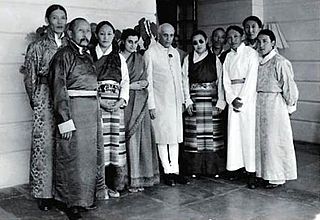
Tsering Dolma was the founder of the non-profit refugee organisation Tibetan Children's Villages and was the older sister of the 14th Dalai Lama, Tenzing Gyatso.

Tibet–India relations are said to have begun during the spread of Buddhism to Tibet from India during the 6th century AD. In 1959, the Dalai Lama fled to India after the failed 1959 Tibetan uprising. Since then, Tibetans-in-exile have been given asylum in India, with the Indian government accommodating them into 45 residential settlements across 10 states in the country, creating the Tibetan diaspora. From around 150,000 Tibetan refugees in 2011, the number fell to 85,000 in 2018, according to government data. Many Tibetans are now leaving India to go back to Tibet and other countries such as United States or Germany. The Government of India, soon after India's independence in 1947, treated Tibet as a de facto independent country. However, more recently India's policy on Tibet has been mindful of Chinese sensibilities, and has recognized Tibet as a part of China.
Tibetan Review is a Tibetan monthly journal and news website published in English, based in Delhi, India. It was first published in Darjeeling, West Bengal in April 1967 by Lodi Gyari. It is well known for its open and vibrant democratic forum for the discussion of the Tibetan problem and other related governmental and social issues on Tibet.

Thubten Samphel was a Tibetan writer, journalist, and government official. He worked as a secretary in the Ministry of Foreign Affairs and was a spokesperson of the Central Tibetan Administration, based in Dharamshala. He also worked for the administration's think tank, Tibet Policy Institute.















